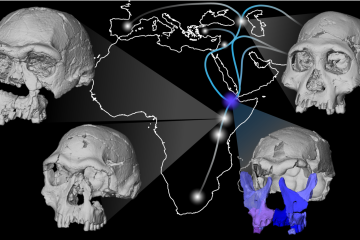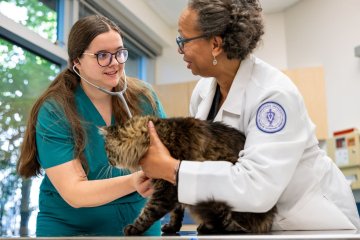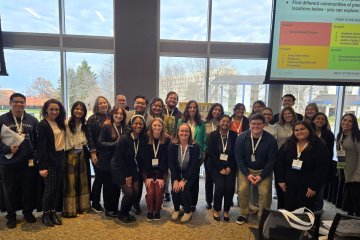Faculty, Students Selected for American Medical Association Research Challenge Finals
Midwestern University has the honor of being represented as one of five nationwide finalists.
- IL - Downers Grove
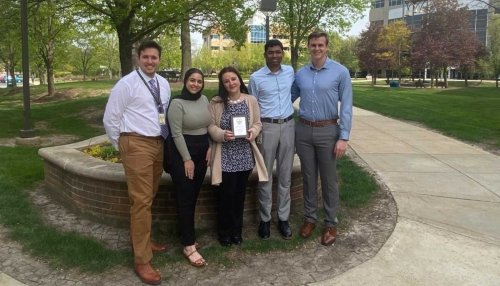
Medical students Garrett Borger and Srujith Medharametla, under the direction of Dr. Martinez-Valenzuela, are finalists at the AMA Research Challenge Finals. From left to right: Kevin Link, Muneebah Vaid, Dr. Martinez-Pena y Valenzuela, Srujith Medharametla, and Garrett Borger.
Representing Midwestern University as one of five nationwide finalists at the American Medical Association (AMA) Research Challenge Finals are Chicago College of Osteopathic Medicine (CCOM) students Srujith Medharametla (CCOM ’26) and Garrett Borger (CCOM ’26), who conducted a research project under the direction of Isabel Martinez-Pena y Valenzuela, Ph.D., Assistant Professor, Physiology, College of Graduate Studies on the Downers Grove Campus. The AMA Research Challenge is a national multi-specialty research conference for medical students, international medical graduates, fellows, and residents to present and show their research. Dr. Martinez-Pena y Valenzuela, Srujith, and Garrett will be at the finals in February.
Their research project, “Effects of Obesity on the Neuromuscular Junction of Genioglossus Muscle and Other Associated Muscles of Respiration” looks at the connection between nerves and muscle as they relate to obesity and obstructive sleep apnea. Specifically, it examines the obesity effects on the genioglossus muscle (GG) which is the largest tongue muscle, and other muscles such as the sternomastoid muscle (ST) and diaphragm muscle. The study focuses on the neuromuscular junction (NMJ), which is the connection point between the motor neurons and the muscles. From the research project, obesity was shown to affect the male mice differently than the female mice. Srujith said, “We have found so far that obesity-induced sleep apnea does impact the NMJ of the tongue muscle and other respiratory muscles, the neck muscle (ST), and the diaphragm. We’ve seen a decrease in receptor (nicotinic acetylcholine receptors) density in the male mice neuromuscular junction of the tongue muscle and neck muscle, but a compensatory increase in receptor density in the diaphragm muscle. There are also other morphological changes occurring at the NMJ and the cells of the tongue muscle. The female mice did not show these effects.”
Srujith added, “It’s very helpful and satisfying to see the reception this research project is getting since this question about the effects of obesity-induced sleep apnea on the neuromuscular junction (NMJ) of the largest extrinsic tongue muscle is very novel. There isn’t much, if any, prior research about this.”
Srujith also described the journey of this research project. The team began working on the project in the spring of 2023. Their 400-word abstract was first chosen for the AMA semifinals, one of about 50 nationwide, he said. At this stage, they presented a poster with a video recording, Srujith said. Past versions of the project were presented and won awards at the Kenneth A. Suarez Research Symposium at Midwestern University and the Great Lakes Chapter of the American Society for Pharmacology and Experimental Therapeutics (GLC-ASPET) conference at the University of Illinois Chicago.
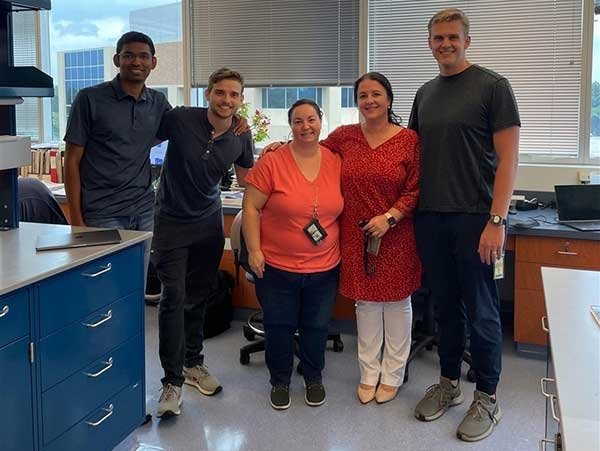
“Garrett and I joined this project in Dr. Martinez-Pena y Valenzuela’s lab because we wanted to build a good foundation for our research experiences in medical school. Her lab offered us this project in physiology that helped us apply what we learned in medical school and learn how to conduct scientific research. We both felt research was important for osteopathic medical students and, therefore, joined her lab in the spring and continued it all summer. Dr. Martinez-Pena y Valenzuela has very kindly guided us in this project and showed us how to properly explore a scientific question in research from all angles and how to welcome new questions. We are both very grateful to Dr. Martinez-Pena y Valenzuela for giving us this opportunity in her lab,” Srujith said.
Srujith added that he and Garrett are grateful for their Midwestern University education that helped prepare them for this project, “Our osteopathic medical education at Midwestern laid the base for our understanding of basic science in such a way that we could understand and benefit from what we were exploring in the lab. This integration of basic science into research prepares us for our careers as future physicians as consolidation of clinical information is key to making proper diagnoses. Midwestern University does a very good job at nudging us to do research and offers us opportunities in various labs.”
In addition, their classmate Kevin Kowal (CCOM ’26) was selected for the AMA poster symposium. Kevin’s research abstract is “The Impact of Cancer-induced Cachexia on the Neuromuscular Synapse.” He joined this project in Dr. Martinez-Pena y Valenzuela’s lab in the summer of 2023.
Research is an integral aspect of the Midwestern University educational experience, with many opportunities for students to expand their skills and knowledge. Research facilities are available for students in both the Downers Grove and Glendale campuses.

